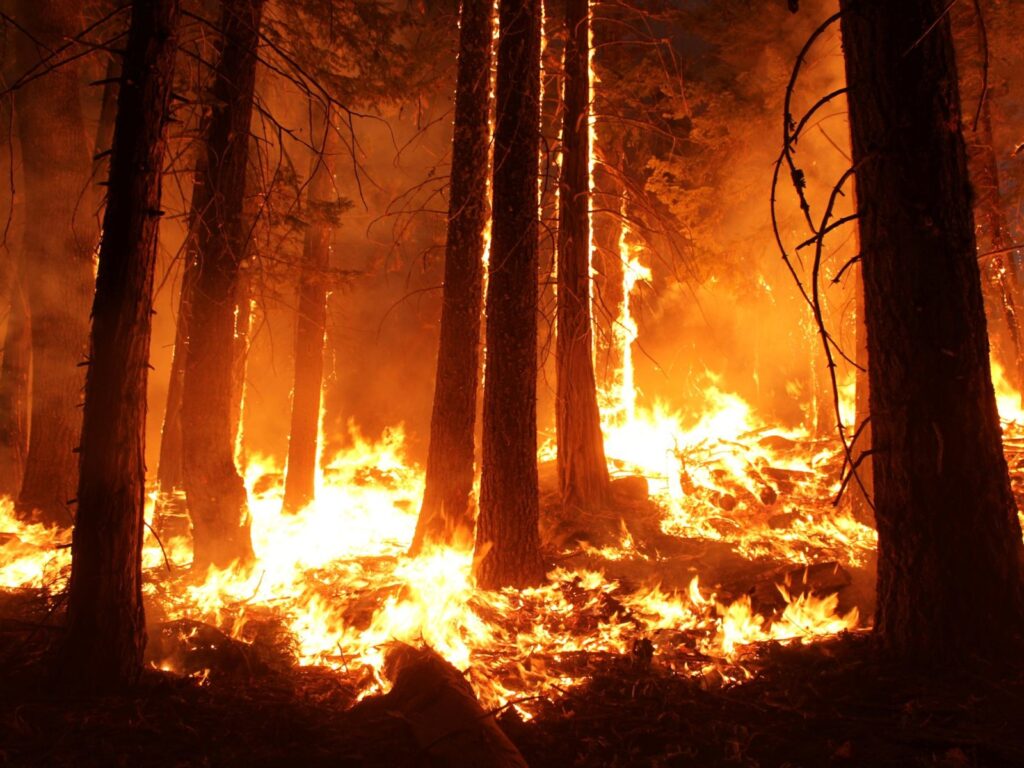Food & Climate
Extreme wildfires are projected to become about 50 percent more frequent by the end of the century, according to the Food and Agriculture Organization of the United Nations (FAO).
The Organization said: environmental changes linked to climate change, such as increased drought, high air temperatures and strong winds, are likely to result in hotter, drier, and longer fire seasons.
(FAO) has released guidelines for countries outlining how to manage the risks of damaging wildfires, which can threaten people and the environment, according to a statement “Food & Climate” platform received.
Wildfires in America and Canada
Meanwhile, there are a lot of wildfires happening around the world right now.
For example, American California’s largest active fire exploded in size on Friday evening, growing rapidly amid bone-dry fuel and threatening thousands of homes as firefighters scrambled to meet the danger, according to “AP”.
The Park Fire’s intensity and rapid spread led fire officials to make unwelcome comparisons to the monstrous Camp Fire, which burned out of control in nearby Paradise in 2018, killing 85 people and torching 11,000 homes.
More than 130 structures have been destroyed by this fire so far, and thousands more remain threatened.
In America also, Oregon wildfires rage across the Pacific Northwest, fueled by wind gusts and lightning, wildfire explodes to half the size of Rhode Island.
Winds and lightning strikes have sparked and fanned wildfires across the Pacific Northwest this week, including the largest fire in the United States, which was rapidly expanding near the Oregon-Idaho border on Friday, according to “hindostantimes”.
And fast-moving fires have destroyed a third of the buildings in the picturesque town of Jasper, Alberta, and its national park in Canada, according to “The New York times”.
Queen Elizabeth II vacationed there, as did her parents before her. Hollywood’s royalty were regular visitors, too. Marilyn Monroe filmed scenes for “River of No Return” there, and “The Emperor Waltz” brought Bing Crosby and Joan Fontaine to its golf courses and tennis courts. The mountains of Jasper, Alberta, have also stood in for peaks around the world in other movies.
Above all, Jasper National Park represented Canada both to the world and for many Canadians for over a century.
Now, tens of thousands of acres of the park and its mountain town of Jasper are either burning in an inferno or have been reduced to rubble and ash. Parks Canada, the national agency, said that since two large-scale wildfires, which sent up a wall of flame more than 300 feet high, were whisked into the community on ferocious winds earlier in the week, 358 of its 1,113 buildings have been destroyed.
Currently, around 340 to 370 million hectares of earth’s surface are burned by wildfire annually. When these wildfires become extreme, they can adversely affect sustainable development, threaten communities’ livelihoods, and generate large volumes of greenhouse gas emissions, according to FAO.
“How we respond to the wildfire challenge is of crucial importance,” said Zhimin Wu, Director of FAO’s Forestry Division, who launched the new edition of the guidelines at a side event during the 9th World Forest Week in Rome. “We must shift our focus from reactive responses to proactive strategies and prioritize prevention and preparedness.”
FAO guidelines

FAO guidelines emphasize the integrated fire management approach, which involves taking action long before, during, and long after a fire. It also recommends strategic actions to support the inclusion of Indigenous Peoples and other local knowledge holders, who contribute valuable, site-specific practices and insights that enhance fire management decisions.
Their active engagement is crucial for preventing wildfires, promptly addressing fire outbreaks, and restoring areas devastated by severe burning, according to the publication.
Furthermore, the guidelines advocate for gender inclusion in integrated fire management, promoting diverse fire knowledge, innovative management options, and scaling up best practices.
Since the initial publication nearly 20 years ago, many countries around the world have used the FAO guidelines to develop public policies and training programmes. With the release of the second edition, even more countries are expected to reference and use the resource.
The release of the updated guidelines is the debut activity of the Global Fire Management Hub, which was launched in 2023 by FAO and UNEP. Supported by the governments of Canada, France, Germany, Portugal, the Republic of Korea and the United States of America, the Fire Hub aims to unite the global fire management community and enhance national capacities for implementing integrated fire management strategies.

